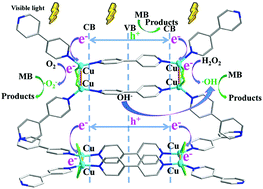Two pure MOF-photocatalysts readily prepared for the degradation of methylene blue dye under visible light†
Abstract
Two 3D metal–organic frameworks (MOFs) with different structures, [Cu(4,4′-bipy)Cl]n (1) and [Co(4,4′-bipy)·(HCOO)2]n (2), were synthesized by means of a hydrothermal method using a typical ligand (4,4′-bipyridine), and characterized by elemental analyses, thermal analyses and single crystal X-ray diffraction. As MOF materials, the two complexes showed active performance for the photodegradation of methylene blue (MB) dye under visible light. MB degradation over the two MOF-based photocatalysts follows first-order kinetics. The addition of an H2O2 electron acceptor can markedly enhance the photocatalytic MB degradation performance via a ligand-to-metal charge transfer mechanism, especially in complex 1. Complex 1 is better than complex 2 in MB photodegradation performance under the same conditions. Moreover, complex 1 showed a stable activity for MB degradation after four consecutive usages. Owing to the advantages of the visible light response, stable structure, low cost and high yield, these MOF-based photocatalysts will facilitate new efforts in environmental purification.



 Please wait while we load your content...
Please wait while we load your content...